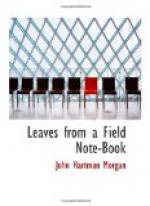Somewhere behind the trenches at varying distances are the batteries. The gunners affect orchards and copses as affording good cover for their guns, and if none are to be found they improvise them. Hop-poles trailed with hops or cut saplings will do very well. Usually there is a delectable garden, which is the peculiar pride of the men. Turf emplacements are constructed for the six guns, and turfed dug-outs house the telephone-operator and the gunners. The battery officers are billeted some way back, usually in a kind of farmhouse, whose chief decorative feature is a midden-heap; in England it would promptly be the subject of a closing order by any Public Health authority.
There is nothing more admirable than a field-gun. As a ship answers her helm or an aeroplane its controls, so does an eighteen-pounder respond to every turn of her elevating and traversing gear. Watch a gunner laying his gun on a target he cannot see; observe him switch the gun round from the aiming point to the target; remark the way in which the sight clinometer registers the angle of sight and the drum registers the range; and then ask yourself whether the smartest ship that ever sailed the high seas could be more docile to a turn of the wheel. With perfect simplicity did a man in the R.F.A. once say to me, “We feel towards our gun as a mother feels to her child; we’d sooner lose our lives than our gun.” In that confession of faith you have the whole of the gunner’s creed.
The heavy guns are generally to be found in splendid isolation; one such I visited and I marvelled at its appearance; it resembled nothing so much as the mottled trunk of a decayed plane-tree except for its girth. “Futurist art,” explained the major deprecatingly as I stared at its daubed surface; “it makes it unrecognisable.” It certainly did. Close by were what looked at a distance like a bed of copper cucumbers. “More gardening?” I asked. “Yes, market gardening,” replied the major; “if we lay the shells like that with sand-bags between them we prevent their igniting one another in case of accidents. It helps us to deliver the goods.”




